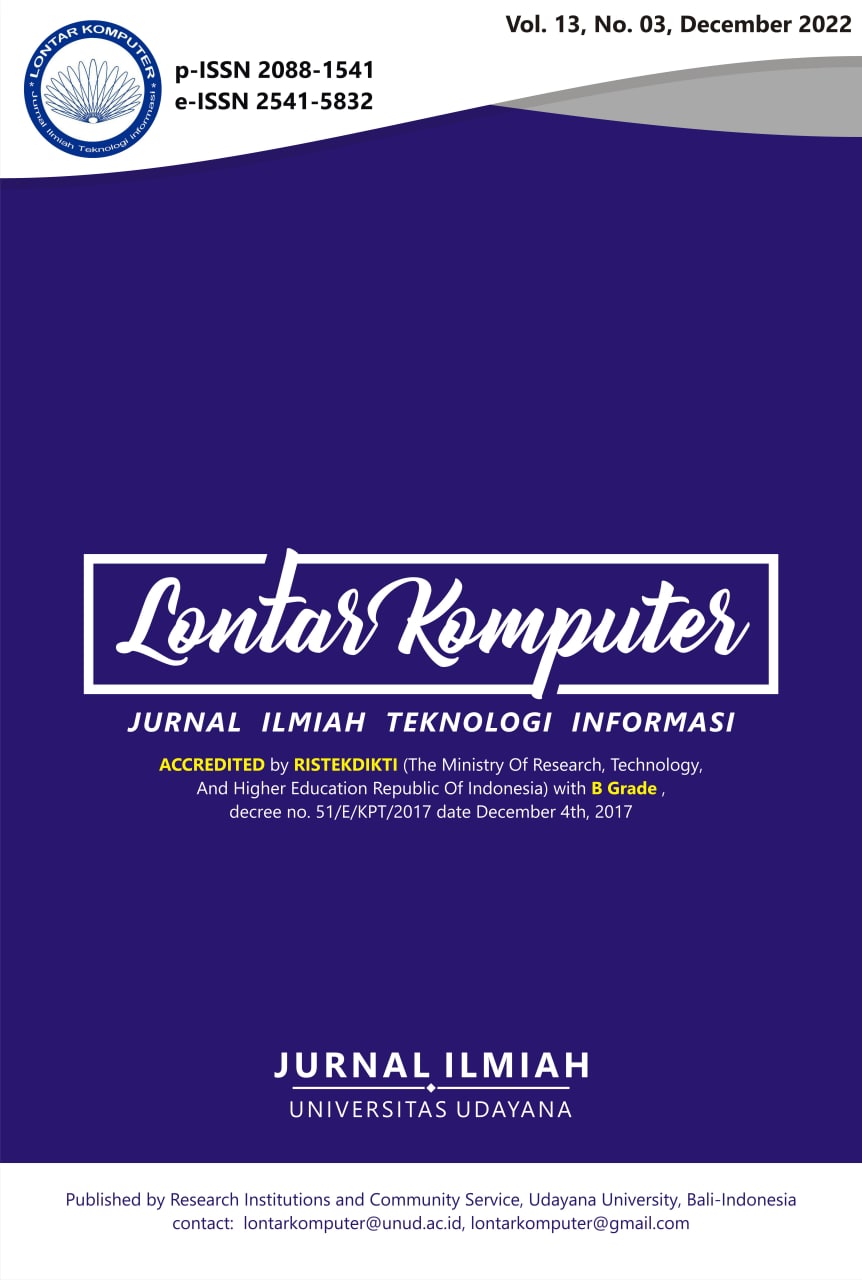Embryo Grading after In Vitro Fertilization using YOLO
Abstract
In vitro fertilization is an implementation of Assistive Reproductive Technology. This technology can produce embryos outside the mother's womb by manipulating gametes outside the human body. The success rate of in vitro fertilization is the selection of good-grading embryos. In this study, the authors used Yolo Version 3 to perform object detection objectively by introducing grades for each embryo image. The author uses an embryo image sourced from the Indonesian Medical Education and Research Institute with information on the quality of the embryo. In this study, the author separated the data into two schemes. The first scheme separates data into training data of 70%, 15% validation data, and 15% for testing data. The second scheme uses a Stratified K-Fold Cross-Validation with a fold value =3. In training, the writer configures the values ??of Max Batches=6000, Steps=4800,5400, Batch=64, and Subdivision=16 by doing image augmentation (saturation=1.5, exposure=1.5, hue=0.1, jitter=0.3, random=1). For each of the obtained mAP (Mean Average Precision) values ??for data separation schemes, one is 100.00% in the 6000th iteration, while for the two-data separation scheme, the highest mAP is 97.33%.% in the fold=3 and 5000th iteration. It means that both separation schemes are sufficient in terms of mAP.
Downloads
References
[2] A. A. Septiandri, A. Jamal, P. A. Iffanolida, O. Riayati, and B. Wiweko, "Human Blastocyst Classification after In Vitro Fertilization using Deep Learning", in The 7th International Conference on Advance Informatics: Concept, Theory, and Applications (ICAICTA), 2020, pp. 1-4.
[3] K. He, X. Zhang, S. Ren, and J. Sun, "Deep Residual Learning on Image Recognition", in the IEEE Conference on Computer Vision and Pattern Recognition, 2016, pp. 770-778.
[4] F, Chollet, "Xception: Deep Learning with Depthwise Separable Convolutions", in the IEEE Conference on Computer Vision and Pattern Recognition, 2017, pp. 1251-1258.
[5] M. Sandler, A. Howard, M. Zhu, A. Zhmoginov and L. C. Chen, "Mobilenetv2: Inverted Residuals and Linear Bottlenecks", in the IEEE Conference on Computer Vision and Pattern Recognition, 2018, pp. 4510-4520.
[6] G. Huang, Z. Liu, L. van der Maaten and K. Q. Weinberger, "Densely Connected Convolutional Network", in the IEEE Conference on Computer Vision and Pattern Recognition, 2017, pp. 4700-4708.
[7] J. Redmon and A. Farhadi, "YOLOv3: An Incremental Improvement", arXiv.org 2018.arXiv:1804.02767, Available URL:https://doi.org/10.48550/arXiv.1804.02767.
[8] Z. Wang, "SEG-YOLO: Real-Time Instance Segmentation using YOLOv3 and Fully Convolutional Network", KTH Royal Institute of Technology Stockholm, School of Electrical Engineering and Computer Science (EECS), 2019.
[9] S. Norling, "Tree Species Classification with YOLOv3: Classification of Silver Birch (Betula Pendula) and Scots Pine (Pinus sylvestris)", KTH Royal Institute of Technology Stockholm, School of Electrical Engineering and Computer Science (EECS), 2019.
[10] A. Han, Y. Zhang, A. Li, C. Li, F. Zhao, Q. D. Liu, Y. Liu, X. Shen, S. Yan, and S. Zhou," Efficient Refinement on YOLOv3 for Real-Time Detection and Assessment of Diabetic Foot Wagner Grades", arXiv.org, arXiv:2006.02322, Available URL: https://doi.org/10.48550/arXiv:2006.02322
[11] M. Nomura, A. Iwase, K. Furui, T. Kitagawa, Y. Matsui, M. Yoshikawa, and F. Kikkawa, "Preferable Correlation to Blastocyst Development and Pregnancy Rates with a New Embryo Grading System Specific for Day 3 Embryos", Journal of Assisted Reproduction and Genetics, vol. 24, no. 1, p.23-28.
[12] A. Ammar, A. Koubaa, M. Ahmed, A. Saad and B. Benjdira, "Vehicle Detection from Aerial Images using Deep Learning: a Comparative Study", Journal Electronics, vol. 10. No. 7, p. 820, 2021.
[13] T. Yu and H. Zhu, "Hyper-Parameter Optimization: A Review of Algorithms and Applications", arXiv.org, 2020, arXiv.2003.05689, Available URL: https://doi.org/10.48550/arXiv.2003.05689.
[14] M. Grandini, E. Bagli, and G. Visani, "Metrics for Multi-Class Classification: an Overview", arXiv.org, 2020, arXiv:2008.05756v1, Available URL: https://doi.org/10.48550/arXiv:2008.05756
[15] A. van Etten," Satellite Imagery Multiscale Rapid Detection with Windowed Network", 2018, arXiv:1809.09978v1, Available URL: https://arxiv.org/pdf/1809.09978.pdf

This work is licensed under a Creative Commons Attribution 4.0 International License.
The Authors submitting a manuscript do so on the understanding that if accepted for publication, the copyright of the article shall be assigned to Jurnal Lontar Komputer as the publisher of the journal. Copyright encompasses exclusive rights to reproduce and deliver the article in all forms and media, as well as translations. The reproduction of any part of this journal (printed or online) will be allowed only with written permission from Jurnal Lontar Komputer. The Editorial Board of Jurnal Lontar Komputer makes every effort to ensure that no wrong or misleading data, opinions, or statements be published in the journal.
 This work is licensed under a Creative Commons Attribution 4.0 International License.
This work is licensed under a Creative Commons Attribution 4.0 International License.























